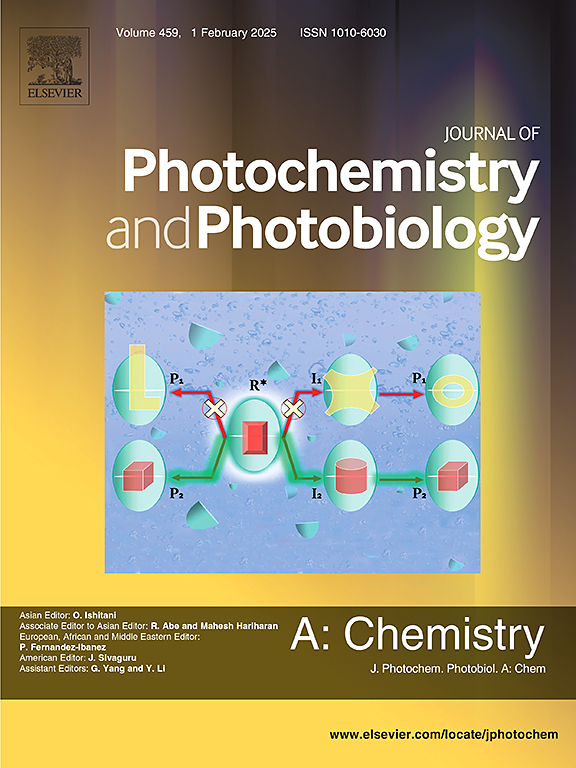Structure, IR spectrum and UV-induced photochemistry of a pyridyl-substituted 1,3,4-oxadiazole-thione in Ar matrix and intermolecular interactions in the neat crystalline phase
IF 4.1
3区 化学
Q2 CHEMISTRY, PHYSICAL
Journal of Photochemistry and Photobiology A-chemistry
Pub Date : 2025-07-09
DOI:10.1016/j.jphotochem.2025.116610
引用次数: 0
Abstract
The structure, infrared (IR) spectrum and UV-induced (λ > 235 nm) photochemistry of 5-(4-pyridyl)-1,3,4-oxadiazole-2(3H)-thione (abbreviated as POT) isolated in a low-temperature argon matrix, at 15 K, were thoroughly investigated. Interpretation of the experimental spectrum was assisted by theoretical calculations undertaken at the DFT(B3LYP)/6–311++G(d,p) level of theory. In the gas phase (and in the cryogenic matrix) the molecule of the compound was found to adopt the thione-amine tautomeric form, where NH is vicinal to C![]() S, i.e., the same tautomeric form previously observed in the neat crystalline form of the compound. Upon sublimation and subsequent deposition into the argon matrix, the compound underwent minor, yet detectable, conversion into other species. These photoproducts were identical to those formed upon in situ broadband UV irradiation (λ > 235 nm) of the matrix-isolated compound. Two different reaction pathways were identified: the first (minor) being the C
S, i.e., the same tautomeric form previously observed in the neat crystalline form of the compound. Upon sublimation and subsequent deposition into the argon matrix, the compound underwent minor, yet detectable, conversion into other species. These photoproducts were identical to those formed upon in situ broadband UV irradiation (λ > 235 nm) of the matrix-isolated compound. Two different reaction pathways were identified: the first (minor) being the C![]() O open-ring reaction leading to the formation of an isocyanate derivative, and the second (major) corresponding to the OCS extrusion generating allenic and propargylic type bond-shift isomeric nitrilimines. The carbodiimide and cyanamide resulting from subsequent rearrangement of the nitrilimines were also observed both in the as-deposited matrix (as a result of the thermally-induced chemistry taking place during sublimation of the compound) and after in situ UV-irradiation of the matrix. The nitrilimines were only captured during the photolysis experiments and were not observed in the spectra of the initially deposited matrix, because they quickly converted to the more stable carbodiimide and cyanamide isomeric forms during matrix deposition. Coupled-cluster calculations with single and double excitations [CCSD/6–311++G(d,p)] were also performed to further characterize the nitrilimines, revealing that the allenic form is slightly more stable than the propargylic one, in agreement with the spectroscopic data. The IR and Raman spectra of the neat crystalline compound were also analyzed in the temperature range of −140 to 220 °C, and the dominant intermolecular interactions in the crystal were elucidated using CrystalExplorer-based analysis of Hirshfeld surfaces and interaction energies. Overall, this study contributes to understanding of the structure, spectroscopy and chemical reactivity of oxadiazoles.
O open-ring reaction leading to the formation of an isocyanate derivative, and the second (major) corresponding to the OCS extrusion generating allenic and propargylic type bond-shift isomeric nitrilimines. The carbodiimide and cyanamide resulting from subsequent rearrangement of the nitrilimines were also observed both in the as-deposited matrix (as a result of the thermally-induced chemistry taking place during sublimation of the compound) and after in situ UV-irradiation of the matrix. The nitrilimines were only captured during the photolysis experiments and were not observed in the spectra of the initially deposited matrix, because they quickly converted to the more stable carbodiimide and cyanamide isomeric forms during matrix deposition. Coupled-cluster calculations with single and double excitations [CCSD/6–311++G(d,p)] were also performed to further characterize the nitrilimines, revealing that the allenic form is slightly more stable than the propargylic one, in agreement with the spectroscopic data. The IR and Raman spectra of the neat crystalline compound were also analyzed in the temperature range of −140 to 220 °C, and the dominant intermolecular interactions in the crystal were elucidated using CrystalExplorer-based analysis of Hirshfeld surfaces and interaction energies. Overall, this study contributes to understanding of the structure, spectroscopy and chemical reactivity of oxadiazoles.

吡啶基取代的1,3,4-恶二唑硫酮在Ar基体中的结构、红外光谱和紫外诱导光化学以及整齐晶相中的分子间相互作用
结构、红外(IR)光谱和紫外诱导(λ >;在15k低温氩气中,研究了5-(4-吡啶基)-1,3,4-恶二唑-2(3H)-硫酮(简称POT)的光化学性质。在DFT(B3LYP)/ 6-311 ++G(d,p)理论水平上进行理论计算,协助解释实验光谱。在气相和低温基质中,化合物分子被发现采用硫胺互变异构形式,其中NH与CS相邻,即与先前在化合物的整齐结晶形式中观察到的相同的互变异构形式。在升华和随后沉积到氩基体后,该化合物经历了轻微但可检测的转化为其他物质。这些光产物与原位宽带紫外辐射形成的光产物相同(λ >;235 nm)。发现了两种不同的反应途径:第一种(次要)是CO开环反应,导致异氰酸酯衍生物的形成;第二种(主要)是OCS挤压产生异丙基和丙基型键移异构体硝基胺。在沉积的基质(由于化合物升华过程中发生的热诱导化学反应)和原位紫外线照射后,也观察到由硝基胺随后重排而产生的碳二亚胺和氰胺。硝基胺只在光解实验中被捕获,而在最初沉积的基质的光谱中没有观察到,因为它们在基质沉积过程中迅速转化为更稳定的碳二亚胺和氰酰胺异构体形式。用单激发和双激发的耦合簇计算[CCSD/ 6-311 ++G(d,p)]进一步表征了硝基亚胺,揭示了异丙基形式比丙炔形式更稳定,与光谱数据一致。在- 140 ~ 220°C的温度范围内分析了整齐结晶化合物的红外和拉曼光谱,并利用基于crystalexplorer的Hirshfeld表面和相互作用能分析阐明了晶体中的主要分子间相互作用。总的来说,这项研究有助于了解恶二唑的结构、光谱和化学反应性。
本文章由计算机程序翻译,如有差异,请以英文原文为准。
求助全文
约1分钟内获得全文
求助全文
来源期刊
CiteScore
7.90
自引率
7.00%
发文量
580
审稿时长
48 days
期刊介绍:
JPPA publishes the results of fundamental studies on all aspects of chemical phenomena induced by interactions between light and molecules/matter of all kinds.
All systems capable of being described at the molecular or integrated multimolecular level are appropriate for the journal. This includes all molecular chemical species as well as biomolecular, supramolecular, polymer and other macromolecular systems, as well as solid state photochemistry. In addition, the journal publishes studies of semiconductor and other photoactive organic and inorganic materials, photocatalysis (organic, inorganic, supramolecular and superconductor).
The scope includes condensed and gas phase photochemistry, as well as synchrotron radiation chemistry. A broad range of processes and techniques in photochemistry are covered such as light induced energy, electron and proton transfer; nonlinear photochemical behavior; mechanistic investigation of photochemical reactions and identification of the products of photochemical reactions; quantum yield determinations and measurements of rate constants for primary and secondary photochemical processes; steady-state and time-resolved emission, ultrafast spectroscopic methods, single molecule spectroscopy, time resolved X-ray diffraction, luminescence microscopy, and scattering spectroscopy applied to photochemistry. Papers in emerging and applied areas such as luminescent sensors, electroluminescence, solar energy conversion, atmospheric photochemistry, environmental remediation, and related photocatalytic chemistry are also welcome.

 求助内容:
求助内容: 应助结果提醒方式:
应助结果提醒方式:


